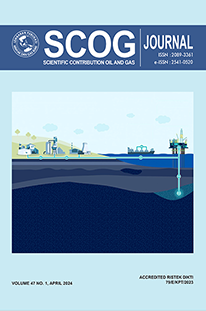Comparison of Facies Estimation of Well Log Data Using Machine Learning
DOI:
https://doi.org/10.29017/SCOG.47.1.1593Keywords:
facies, well logging, machine learning, supervised learningAbstract
Accurately identifying lithological facies is crucial for comprehending geological variations in a proven reservoir. To enhance the accuracy of facies classification compared to previous studies on the same dataset, five distinct machine learning algorithms were employed to predict facies in both a panoma field dataset and Z-Field, Indonesia. The analysis data samples with known facies, originating from core data from Panoma Field and Z-Field. Facies classification was addressed using five well-known classification algorithms, namely K-Nearest Neighbor (KNN), Support Vector Machine (SVM), Neural Network Classifier (NNC), Random Forest Classifier (RFC), and Decision Tree Classifier (DTC). The dataset was divided into training and testing subsets to evaluate the machine learning models. The five suggested algorithms demonstrate effective facies prediction, closely aligning with the actual facies in the test wells within the Panoma field. However, these algorithms struggle to predict facies accurately in the Z field well, primarily attributed to the imbalanced data distribution between sandstone-claystone and siltstone-limestone. Equalizing the number of facies labels in the training data becomes essential to enable the algorithm to recognize patterns and accurately estimate all facies typesReferences
Al-Mudhafar, W. J. (2017). Integrating well log interpretations for lithofacies classification and permeability modeling through advanced machine learning algorithms. Journal of Petroleum Exploration and Production Technology, 7(4), 1023–1033. https://doi.org/10.1007/s13202-017-0360-0
Al-Mudhafar, W. J., Abbas, M. A., & Wood, D. A. (2022). Performance evaluation of boosting machine learning algorithms for lithofacies classification in heterogeneous carbonate reservoirs. Marine and Petroleum Geology, 145, 105886. https://doi.org/10.1016/j.marpetgeo.2022.105886
Dell’Aversana, P. (2019). Comparison of different Machine Learning algorithms for lithofacies classification from well logs. Bollettino Di Geofisica Teorica Ed Applicata, 60(1).
Dixit, N., McColgan, P., & Kusler, K. (2020). Machine Learning-Based Probabilistic Lithofacies Prediction from Conventional Well Logs: A Case from the Umiat Oil Field of Alaska. Energies, 13(18), Article 18. https://doi.org/10.3390/en13184862
Dramsch, J. S. (2019). Machine learning in 4D seismic data analysis: Deep neural networks in geophysics.
Dubois, M. K., Bohling, G. C., & Chakrabarti, S. (2007). Comparison of four approaches to a rock facies classification problem. Computers & Geosciences, 33(5), 599–617. https://doi.org/10.1016/j.cageo.2006.08.011
Hall, M. (2016). A user guide to the geophysical tutorials. The Leading Edge, 35(2), 190–191. https://doi.org/10.1190/tle35020190.1
Hardanto, L. T., & Wulandhari, L. A. (2021). Lithofacies Classification Using Supervised and Semi-Supervised Machine Learning Approach. International Journal on Advanced Science, Engineering and Information Technology, 11(2), 542. https://doi.org/10.18517/ijaseit.11.2.11764
Imamverdiyev, Y., & Sukhostat, L. (2019). Lithological facies classification using deep convolutional neural network. Journal of Petroleum Science and Engineering, 174, 216–228. https://doi.org/10.1016/j.petrol.2018.11.023
Mandal, P. P., & Rezaee, R. (2019). Facies classification with different machine learning algorithm – An efficient artificial intelligence technique for improved classification. ASEG Extended Abstracts, 2019(1), 1–6. https://doi.org/10.1080/22020586.2019.12072918
Merembayev, T., Kurmangaliyev, D., Bekbauov, B., & Amanbek, Y. (2021). A Comparison of Machine Learning Algorithms in Predicting Lithofacies: Case Studies from Norway and Kazakhstan. Energies, 14(7), Article 7. https://doi.org/10.3390/en14071896
Mohamed, I. M., Mohamed, S., Mazher, I., & Chester, P. (2019). Formation Lithology Classification: Insights into Machine Learning Methods. Day 2 Tue, October 01, 2019, D021S033R005. https://doi.org/10.2118/196096-MS
Prabowo, U. N., Ferdiyan, A., Raharjo, S. A., Sehah, S., & Candra, A. D. (2023). Comparison Of Facies Estimation Using Support Vector Machine (SVM) And K-Nearest Neighbor (KNN) Algorithm Based On Well Log Data. Aceh International Journal of Science and Technology, 12(2), Article 2. https://doi.org/10.13170/aijst.12.2.28428
Pratama, H., Syahputra, L. A., Albany, M. F., Abdullah, A., Suhardja, S. K., Kusumah, E., Astuti, W., & Mujihardi, B. (2020). Early Results of Comparison between K-Nearest Neighbor and Artificial Neural Network Method for Facies Estimation. Jurnal Geofisika, 18(1), 7–13.
Saroji, S., Winata, E., Pratama, P., Hidayat, W., Prakoso, S., & Herdiansyah, F. (2021). The implementation of machine learning in lithofacies classification using multi well logs data. Aceh Int. J. Sci. Technol, 10, 9–17.
Singh, H., Seol, Y., & Myshakin, E. M. (2020). Automated Well-Log Processing and Lithology Classification by Identifying Optimal Features Through Unsupervised and Supervised Machine-Learning Algorithms. SPE Journal, 25(05), 2778–2800. https://doi.org/10.2118/202477-PA
Downloads
Published
Issue
Section
License
Copyright (c) 2024 SCIENTIFIC CONTRIBUTIONS OIL AND GAS (SCOG)

This work is licensed under a Creative Commons Attribution 4.0 International License.
Authors are free to Share — copy and redistribute the material in any medium or format for any purpose, even commercially Adapt — remix, transform, and build upon the material for any purpose, even commercially.
The licensor cannot revoke these freedoms as long as you follow the license terms, under the following terms Attribution — You must give appropriate credit , provide a link to the license, and indicate if changes were made . You may do so in any reasonable manner, but not in any way that suggests the licensor endorses you or your use.
No additional restrictions — You may not apply legal terms or technological measures that legally restrict others from doing anything the license permits.














